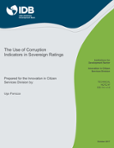The Use of Corruption Indicators in Sovereign Ratings
Date
Oct 2017
This paper studies the relationship between sovereign ratings and corruption indicators. The paper first shows a strong correlation between ratings issued by the three main rating agencies (Standard & Poor’s, Moody’s, and Fitch) and three commonly used corruption indicators. This correlation is robust to controlling for the fact that corruption is also correlated with level of development, amount of government debt, the current account balance, and an indicator of macroeconomic instability. However, the conditional correlation between corruption and sovereign ratings is not generally robust to controlling for the fact that corruption is correlated with other governance indicators. Moreover, using standard statistical techniques it is not possible to establish whether the observed correlation implies a causal effect going from corruption indicators to sovereign ratings. Next, the paper briefly describes the sovereign rating methodologies of the three main agencies and shows that they incorporate corruption indicators in their rating criteria. There are, however, differences in the way in which corruption indicators affect the ratings issued by the three agencies. While Fitch has well-defined quantitative criteria for incorporating corruption in its rating opinions, Standard & Poor’s uses a qualitative assessment of the risks arising from corruption, and the criteria used by Moody’s lie somewhere in between.



